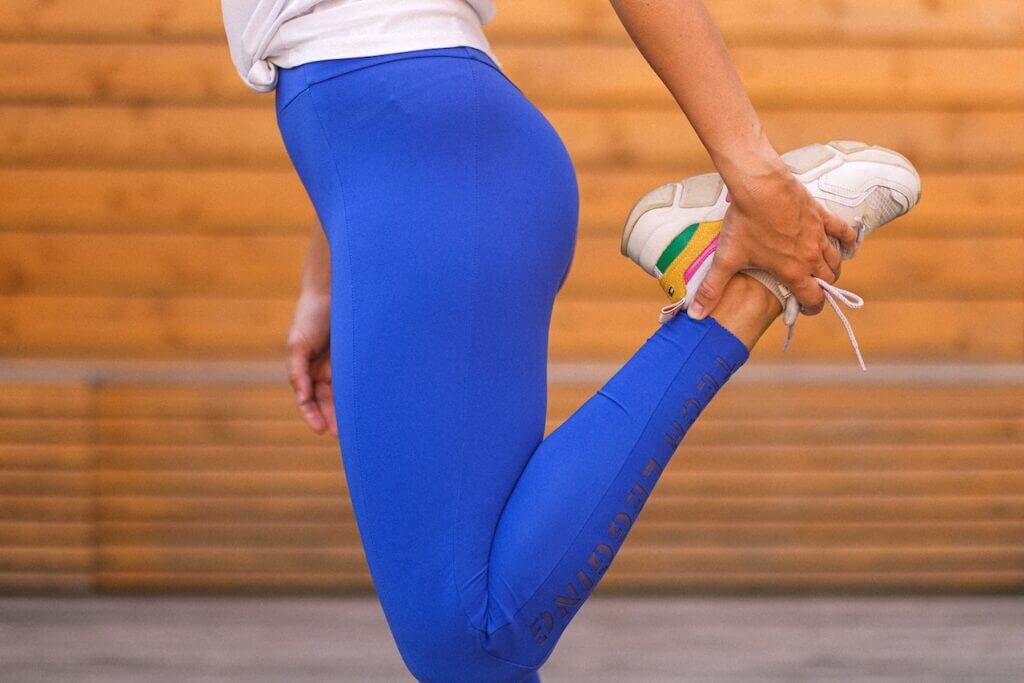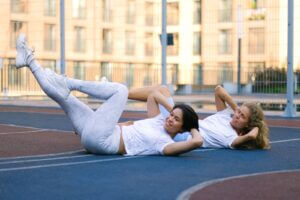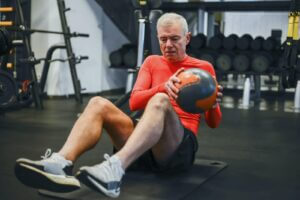A proper warm-up sets the stage for a successful run, enhancing performance and reducing the risk of injury. In this blog post, we’ll reveal seven essential warm-up drills for runners. These drills act as the ignition switch, priming muscles and joints for the miles ahead.
Whether you’re chasing a personal best or seeking an enjoyable run, these drills are your secret weapon. Get ready to maximize your potential and stay injury-free as we explore the essential warm-up drills every runner should know. Let’s hit the ground running!
Table of Contents
Drill 1: Dynamic Stretching

Dynamic stretching is a fantastic warm-up drill that helps you prepare your body for the upcoming run. Unlike static stretching, where you hold a stretch for an extended period, dynamic stretching involves moving your muscles and joints through a full range of motion. This type of stretching is ideal for increasing blood flow, activating your muscles, and improving flexibility—all essential components for a successful run.
So, let’s dive into some dynamic stretching exercises that will get you primed and ready to hit the pavement!
Exercise 1: Leg Swings
Leg swings are a fantastic way to loosen up your hips, hamstrings, and quadriceps. Find a wall or sturdy object to hold onto for balance. Stand sideways to the wall, placing one hand against it. Swing one leg forward and backward in a controlled manner, keeping your core engaged. Aim for 10 to 15 swings on each leg. This exercise helps improve your hip mobility and warms up the muscles you’ll be using while running.
Exercise 2: Arm Circles
Arm circles are simple yet effective in warming up your shoulders and upper body. Stand with your feet shoulder-width apart and extend your arms out to the sides. Begin making small circles with your arms, gradually increasing the size of the circles. After a few rotations, reverse the direction. Perform 10 to 15 circles in each direction. This exercise helps improve the range of motion in your shoulders and prepares your upper body for a smooth and balanced running stride.
Exercise 3: Walking Toe Touches
Walking toe touches are a great way to stretch your hamstrings and improve your balance. Start by standing tall with your feet hip-width apart. Take a step forward with your right foot and lift your left leg straight out in front of you. Reach down with your right hand and touch your left toes, then stand back up and repeat on the other side. Aim for 10 to 12 repetitions on each leg. This exercise helps lengthen your hamstrings and activate your core muscles.
Remember, dynamic stretching should be done in a controlled and fluid manner. Avoid jerky movements or bouncing, as this can increase the risk of injury. Take your time and focus on engaging the appropriate muscles throughout each exercise.
By incorporating these dynamic stretching exercises into your warm-up routine, you’ll activate your muscles, increase blood flow, and enhance your overall flexibility. This preparation sets the stage for a successful and injury-free run. So, give them a try and feel the difference in your performance and comfort level during your next run!
Next up, we’ll explore another essential warm-up drill: high knees. Get ready to elevate your heart rate and engage those leg muscles for an energized start to your run!
Drill 2: High Knees
High knees are a fantastic warm-up drill that can get your heart pumping and muscles firing, preparing you for a great run ahead. This exercise targets your leg muscles while also improving coordination and balance. Let’s dive into how to perform high knees correctly:
- Start by standing tall with your feet hip-width apart.
- Begin jogging in place but with an extra emphasis on lifting your knees as high as possible.
- As you lift your knee, drive the opposite arm forward to mimic a natural running motion.
- Aim to keep your core engaged and your posture upright throughout the exercise.
- Continue performing high knees for about 30 seconds to a minute, gradually increasing the duration as you become more comfortable.
Remember these key tips to make the most out of high knees
- Focus on the height of your knees rather than speed. This will ensure proper engagement of your hip flexors and quadriceps.
- Land softly on the balls of your feet to minimize impact and reduce stress on your joints.
- Maintain a brisk pace, but don’t sacrifice form for speed. Proper form is crucial for maximizing the benefits of this warm-up drill.
High knees help improve leg strength, activate your core muscles, and enhance coordination, all of which contribute to better running performance. By incorporating this drill into your warm-up routine, you’ll increase blood flow to your lower body and loosen up your muscles, preparing them for the demands of running.
Ready to take your warm-up routine to the next level? Check out our blog post on “Effective Knee Warm-Up Routine for a Smooth and Safe Run.” Discover essential exercises and tips specifically targeting your knees, ensuring they’re primed and protected for your runs.
So, next time you hit the pavement, don’t forget to include high knees in your warm-up routine.
Drill 3: Butt Kicks
Now it’s time to get those legs pumping and prepare your quads and hamstrings with a fantastic warm-up drill called butt kicks. This dynamic exercise is not only fun but also highly effective in getting your muscles ready for a great run. So let’s dive into the details and learn how to perform butt kicks like a pro!
Butt kicks, as the name suggests, involve bringing your heels up toward your glutes with each stride. Here’s how you can do it:
- Find a comfortable space, preferably outdoors or on a treadmill, where you have enough room to move forward without any obstacles.
- Begin jogging slowly, making sure to maintain an upright posture and engage your core muscles.
- As you jog, focus on lifting your heels towards your glutes with each step, aiming to touch your glutes lightly. It’s important to keep your knees pointed downwards and avoid excessive kicking motion.
- Start with a gentle pace and gradually increase the intensity as your muscles warm up.
- Remember to breathe steadily throughout the exercise, inhaling and exhaling naturally.
Butt kicks offer several benefits for runners. They actively engage your quadriceps and hamstrings, helping to improve their flexibility and range of motion. By performing this drill, you also activate the muscles around your hips, which play a crucial role in your running mechanics.
While performing butt kicks, pay attention to your form and avoid any sudden jerky movements that may strain your muscles. It’s always better to start slowly and gradually increase the intensity to prevent any potential injuries.
Incorporating butt kicks into your warm-up routine before each run will not only prepare your muscles but also improve your running efficiency and performance. Plus, it adds an element of fun and playfulness to your warm-up, making it an enjoyable part of your running routine.
So, lace up those running shoes, find a suitable spot, and give butt kicks a try. Your quads, hamstrings, and hips will thank you for it!
Remember, taking a few minutes to perform warm-up drills like butt kicks can make a world of difference in your running experience. Let’s keep those muscles limber, prevent injuries, and set ourselves up for a successful and enjoyable run!
Drill 4 – Walking Lunges
Walking lunges are a fantastic warm-up drill that engages multiple muscle groups while also increasing flexibility and stability. By incorporating walking lunges into your pre-run routine, you’ll prepare your body for the demands of running and reduce the risk of muscle imbalances or injuries. So, let’s dive into the details of this essential warm-up drill!
Step-by-step instructions
- Start by standing up straight with your feet hip-width apart and your hands on your hips or at your sides.
- Take a controlled step forward with your right leg, ensuring that your torso remains upright and your core is engaged.
- Lower your body down by bending both knees until your front thigh is parallel to the ground, and your back knee hovers just above the floor. Aim for a 90-degree angle in both knees.
- Push off with your back foot and bring it forward, stepping into the next lunge.
- Repeat the process, alternating legs and moving forward in a continuous motion.
When performing walking lunges, keep the following tips in mind
- Keep your front knee aligned with your ankle. Avoid letting it extend past your toes to prevent unnecessary strain on your knee joint.
- Engage your core muscles to maintain stability and balance throughout the movement.
- Maintain an upright posture with your chest lifted and shoulders relaxed.
- Take long strides to engage your glutes and hamstrings effectively.
Benefits of Walking Lunges
- Improved hip flexibility: Walking lunges engage the hip flexors, helping to increase your range of motion and stride length.
- Strengthened leg muscles: The quadriceps, hamstrings, and glutes all get a good workout during walking lunges, helping to build strength and endurance.
- Enhanced stability: This exercise challenges your balance and stability, which is essential for maintaining proper form and preventing injuries while running.
- Activation of the core: Walking lunges engage your core muscles, promoting stability and better posture while you run.
Remember, warming up with walking lunges before your run will help prepare your body for the workout ahead. Take your time and focus on maintaining proper form throughout the exercise. Start with a few sets of 10-12 lunges on each leg, gradually increasing the number as you become more comfortable.
Now that you’ve learned about walking lunges as an essential warm-up drill, it’s time to give them a try! Incorporate this exercise into your pre-run routine, and you’ll notice the difference in your performance and overall running experience. Get ready to hit the road with strength, stability, and a smile on your face!
Drill 5: Ankle Circles
When it comes to running, our ankles play a crucial role in absorbing impact and providing stability. That’s why it’s essential to warm up the ankle joints before hitting the pavement. One effective warm-up drill for the ankles is ankle circles.
Ankle circles are simple yet powerful exercises that can help improve ankle mobility and prevent common running injuries like sprains and strains. By incorporating ankle circles into your warm-up routine, you’ll enhance the range of motion in your ankles, allowing for smoother, more efficient strides.
Step-by-Step Instructions
- Stand tall with your feet shoulder-width apart.
- Lift one foot off the ground, keeping the other foot firmly planted.
- Begin by rotating your ankle clockwise, making small circles with your toes.
- Gradually increase the size of the circles, ensuring that your movements are controlled.
- After a few rotations in one direction, switch to counterclockwise circles.
- Perform 10 to 15 circles in each direction for each ankle.
Remember to maintain proper form and avoid any pain or discomfort during the exercise. You should feel a gentle stretch in the muscles and tendons surrounding your ankle.
Ankle circles are a quick and effective way to warm up your ankles before a run. By incorporating them into your routine, you’ll activate the ankle joints, increase blood flow, and improve overall ankle stability. This will not only enhance your running performance but also help prevent ankle-related injuries that can sideline you from your favorite activity.
So, before you embark on your next run, take a few minutes to show some love to your ankles with ankle circles. Your ankles will thank you, and you’ll be ready to conquer the road or trail with confidence!
Drill 6: Skipping
Skipping isn’t just for kids on the playground—it’s also an excellent dynamic warm-up drill for runners. You might feel a bit silly at first, but trust me, the benefits are worth it. Skipping engages multiple muscle groups and helps improve coordination, making it an ideal warm-up exercise before hitting the pavement. So, let’s dive into the world of skipping and get those legs moving!
Benefits of Skipping
Skipping offers a host of benefits that can enhance your running performance. Firstly, it activates and warms up your leg muscles, including your calves, quads, and hamstrings. Doing so, prepares them for the upcoming demands of running and reduces the risk of muscle strains or pulls.
Moreover, skipping is a great way to improve coordination. The rhythmic motion of lifting your knees and extending your legs while maintaining balance challenges your coordination skills and helps synchronize your upper and lower body movements. This synchronization is crucial for efficient running form, allowing you to conserve energy and maintain a smooth stride.
Step-by-Step Instructions for Skipping Exercises
Ready to give skipping a try? Here’s a step-by-step guide to help you get started:
- Stand tall with your feet hip-width apart, and relax your arms by your sides.
- Begin by hopping lightly on one foot while simultaneously lifting the opposite knee towards your chest.
- As you lower the lifted knee, push off the ground with your standing foot and switch to the other leg, repeating the same motion.
- Coordinate your arm movements by swinging them naturally in sync with your leg movements. For example, when the right knee is up, the left arm should be forward, and vice versa.
- Keep the skips light and springy, focusing on maintaining a relaxed and fluid motion.
- Continue skipping for a designated distance or period, gradually building up your speed and intensity as you warm up.
Remember, the goal is not to break any world records with your skipping speed. Instead, focus on maintaining good form and gradually increasing the intensity as your body warms up.
Incorporating skipping into your warm-up routine can bring a playful element to your runs while reaping significant benefits. So, next time you’re lacing up your running shoes, give skipping a go and witness the positive impact it can have on your overall performance.
Drill 7: Arm Swings
When it comes to warm-up drills for runners, we can’t overlook the importance of arm swings. While running primarily engages the lower body, the upper body plays a crucial role in maintaining balance, stability, and overall efficiency.
That’s where arm swings come into play. They not only help loosen up your upper body but also promote proper arm mechanics that can significantly enhance your running performance. Let’s dive into the world of arm swings and discover how to incorporate them into your warm-up routine!
Benefits of Arm Swings
First, let’s talk about the benefits of arm swings. By performing arm swings before your run, you’ll effectively warm up the muscles in your shoulders, chest, and back. This increased blood flow prepares these areas for the demands of running, reducing the risk of strains or discomfort during your workout. Additionally, proper arm mechanics can improve your running posture and help you maintain a steady rhythm.
Now, let’s explore a few different types of arm swings you can incorporate into your warm-up routine:
1. Forward Arm Swings
Stand tall with your feet shoulder-width apart. Start swinging your arms forward in a controlled manner, simultaneously moving them from your sides to shoulder height and back. Keep your elbows slightly bent and maintain a relaxed but engaged posture throughout. Aim for a smooth and fluid motion.
2. Backward Arm Swings
Similar to forward arm swings, stand with your feet shoulder-width apart. This time, swing your arms backward, bringing them from shoulder height to your sides and back. Remember to maintain proper form with relaxed but engaged muscles. Focus on the backward motion to activate your upper back and shoulders.
3. Cross-Body Arm Swings
Standing tall, start swinging your right arm across your body towards the left side, and then swing it back to the right side. Repeat the same motion with your left arm, crossing it towards the right side. Alternate the swinging motion from side to side, keeping your arms relaxed but purposeful. This exercise helps engage the muscles across your torso and promotes rotational mobility.
As you perform these arm swings, pay attention to your form. Keep your movements controlled and smooth, avoiding any sudden or jerky motions. Focus on the range of motion that feels comfortable for you, gradually increasing it over time as your muscles warm up.
Remember, the goal of arm swings is to warm up and mobilize your upper body, so don’t rush through them. Take your time, breathe deeply, and enjoy the rhythm of the swings. Consider pairing them with other warm-up exercises to create a comprehensive routine that prepares your entire body for the upcoming run.
Incorporating arm swings into your warm-up routine can make a remarkable difference in your running performance. They will not only help you avoid potential injuries but also optimize your arm movements, resulting in a more efficient and enjoyable running experience.
Conclusion
In conclusion, mastering the art of warm-up drills can truly elevate your running experience. By incorporating these seven essential warm-up drills into your routine, you are not only priming your body for optimal performance but also safeguarding yourself against potential injuries.
Remember, dynamic stretching opens the gateway to increased flexibility and range of motion, while high knees and butt kicks ignite explosive power in your legs. Walking lunges activate those crucial glutes and hip flexors, and ankle circles promote fluidity and stability in your footwork. Skipping brings out your inner childlike joy while activating multiple muscle groups, and arm swings ensure that your upper body is in perfect sync with your lower body.
As a runner, you owe it to yourself to maximize your potential, to tap into the incredible strength and endurance that lies within. These warm-up drills are the key to unlocking that potential, allowing you to push your boundaries and achieve greatness on the track or trail.
So lace up your shoes, embrace the rhythm of your breath, and embark on your running journey armed with these essential warm-up drills. Witness the transformation as your runs become smoother, your strides more powerful, and your body more resilient.


